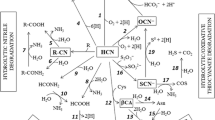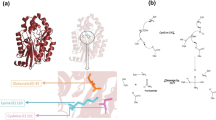Abstract
Cyanide is an important industrial chemical produced on a grand scale each year. Although extremely toxic to mammalian life, cyanide is a natural product generated by fungi and bacteria, and as a result microbial systems have evolved for the degradation of cyanide to less toxic compounds. The enzymes which utilize cyanide as a substrate can be categorized into the following reaction types: substitution/addition, hydrolysis, oxidation, and reduction. Each of these categories is reviewed with respect to the known biochemistry and feasibility for use in treatment of cyanide containing wastes.
Similar content being viewed by others
References
AkopyanTN, BraunsteinAE & GoryachenkovaEV (1975) Beta-cyanoalanine synthase: purification and characterization. Proc. Nat. Acad. Sci. USA 72: 1617–1621
AtkinsonA (1975) Bacterial cyanide detoxification. Biotech. Bioeng. 17: 457–460
BasheerS, KutO, PrenosilJ & BourneJ (1992) Kinetics of enzymatic degradation of cyanide. Biotech. and Bioeng. 39: 629–634
BraunsteinAE & GoryachenkovaE (1984) The β-replacement specific pyridoxal-P lyases. Adv. Enzymol. 56: 1–89
CastricPA (1981) The metabolism of hydrogen cyanide by bacteria. In: VenneslandB, ConnEE, KnowlesCJ, WestleyJ & WissingF (Eds) Cyanide in Biology (pp 233–261). Academic Press, New York
CerlettiP (1986) Seeking a better job for an under-employed enzyme: Rhodanese. Trends in Biochem. Sci. 11: 369–372
ChurchichJE (1986) Pyridoxal phosphate enzymes catalyzing γ elimination or replacement. In: DolphinD, PoulsonR & AvramovicO (Eds) Vitamin B6 Pyridoxal Phosphate Chemical, Biochemical, and Medical Aspects, Part B (pp 311–324). John Wiley & Sons, New York
ClarkePM (1986) Enzymatic treatment of cyanide bearing effluents. In: EcclesH & HuntS (Eds) Immobilision Ions Bio-sorption (pp 245–256). Howard, Chichester, UK
DorrPK & KnowlesCJ (1989) Cyanide oxygenase and cyanase activities of Pseudomonas fluorescens NCIMB 11764. FEMS Microbiol. Lett. 60: 289–294
EveredD & HarnettS (1988) Cyanide Compounds in Biology. John Wiley & Sons, New York
FallonRD, CooperDA, SpeeceR & HensonM (1991) Anaerobic biodegradation of cyanide under methanogenic conditions. Appl. Environ. Microbiol. 57: 1656–1662
FedorakPM & HrudeySE (1987) Inhibition of anaerobic degradation of phenolics and methanogenesis by coal coking wastewater. Water Sci. Tech. 19: 219–228
FedorakPM & HrudeySE (1989) Cyanide transformation in anaerobic phenol-degrading methanogenic cultures. Water Sci. Tech. 21: 67–76
FedorakPM, RobertsDJ & HrudeySE (1986) The effects of cyanide on the methanogenic degradation of phenolic compounds. Water Res. 20: 1315–1320.
FerrisJP (1983) Biological formation and metabolic transformations of compounds containing the cyano group. In: PataiS & RappoportZ (Eds) The Chemistry of Functional Groups Supplement C (pp 325–339). John Wiley & Sons, New York
FinneganI, ToerienS, AbbotL, SmitF & RaubenheimerHG (1991) Identification and characterisation of an Acinetobacter sp. capable of assimilation of a range of cyano-metal complexes, free cyanide ions, and simple nitriles. Appl. Microbiol. Biotech. 36: 142–144
FryWE & EvansPH (1977) Association of formamide hydrolyase with fungal pathogenicity to cyanogenic plants. Phytopathology 67: 1001–1006
FryWE & MillarRL (1972) Cyanide degradation by an enzyme from Stemphylium Ioti. Arch. Biochem. Biophys. 151: 468–474
FryWE & MyersDF (1981) Hydrogen cyanide metabolism by fungal pathogens of cyanogenic plants. In: VenneslandB, ConnEE, KnowlesCJ, WestleyJ & WissingF (Eds) Cyanide in Biology (pp 321–334). Academic Press, New York
HardyRWF & KnightJrE (1967) ATP-dependent redeuction of azide and HCN by N2-fixing enzymes of Azotobacter vinelandii and Clostridium pasteurianum. Biochim. Biophys. Acta. 139: 69–90
HarrisR & KnowlesCJ (1983) Isolation and growth of a Pseudomonas species that utilizes cyanide as a source of nitrogen. J. Gen. Microbiol. 129: 1005–1011
HarrisRE, BunchAW & KnowlesCJ (1987) Microbial cyanide and nitrile metabolism. Sci. Prog. (Oxford) 71: 293–304
HarrisRE & KnowlesCJ (1983) The conversion of cyanide to ammonia by extracts of a strain of Pseudomonas fluorescens that utilizes cyanide as a source of nitrogen for growth. FEMS Microbiol. Lett. 20: 337–341
HendricksonHR & ConnEE (1969) Cyanide metabolism in higher plants IV. Purification and properties of the β-cyanoalanine synthase of blue lupine. J. Biol. Chem. 244: 2632–2640
HolWGJ, LijkLJ & KalkKH (1983) The high resolution three-dimensional structure of bovine liver rhodanese. Fundam. Appl. Toxicol. 3: 370–376
HopeKM & KnowlesCJ (1991) The anerobic utilisation of cyanide in the presence of sugars by microbial cultures can involve an abiotic process. FEMS Microbiol. Lett. 80: 217–220
HoweR (1965) Bio-destruction of cyanide wastes-advantages and disadvantages. Int. J. Air Water Pollut. 9: 468–478
IkegamiF, TakayamaK & MurakoshioI (1988a) Purification and properties of β-cyano-L-alanine synthase from Lathyrus latifolius. Phytochemistry 27: 3385–3389
IkegamiF, TakayamaK, TajimaC & MurakoshiI (1988b) Purification and properties of β-cyano-L-alanine synthase from Spinacia oleracea. Phytochemistry 27: 2011–2016
Ingvorsen K & Godtfredsen SE (1988) Microbial cyanide converting enzymes, their production and use. European Patent Application EP 282351
IngvorsenK, Hojer-PedersenB & GodtfredsenSE (1991) Novel cyanide-hydrolyzing enzyme from Alcaligenes xylosoxidans subsp. denitrificans. Appl. Environ. Microbiol. 57: 1783–1789
IngvorsenK, YdeB, GodtfredsenS & TsuchiyaR (1988) Microbial hydrolysis of organic nitriles and amides. In: EveredD & HarnettS (Eds) Cyanide Compounds in Biology (pp 16–31). John Wiley & Sons, New York
JaegerK & DotterweichE (1986) Reduction of cyanides by the nitrogenase-systems of free-living diazotrophic bacteria in the sediment of river Alster (Hamburg). Arch. Hydrobiol. 107: 249–259
JarabakR (1981) 3-Mercaptopyruvate sulfurtransferase. Meths. Enzymol. 77: 291–297
KlenkH, GriffithsA, HuthmacherK, ItzelH, KnorreH, VoigtC & WeibergO (1988) Cyano compounds, inorganic. In: GerhartzW (Ed) Ullman's Encyclopedia of Industrial Chemistry (pp 159–190). VCH Publishers, New York
KnowlesCJ (1976) Microorganisms and cyanide. Bacteriol. Rev. 40: 652–680
KnowlesCJ (1988) Cyanide utilization and degradation by microorganisms. In: EveredD & HarnettS (Eds) Cyanide Compounds in Biology (pp 3–15). John Wiley & Sons, Ltd, Chichester, UK
KunzDA & NagappanO (1989) Cyanase-mediated utilization of cyanate in Pseudomonas flourescens NCIMB 11764. Appl. Environ. Microbiol. 55: 256–258
LauingerC & ResslerC (1970) β-Cyanoalanine as a substrate for asparaginase, stoichiometry, kinetics and inhibition. Biochim. Biophys. Acta. 198: 316–323
LiJ, BurgessBK & CorbinJL (1982) Nitrogenase reactivity: cyanide as substrate and inhibitor. Biochemistry 21: 4393–4402
LoweDJ, FisherK, ThorneleyRNF, VaughnSA & BurgessBK (1989) Kinetics and mechanism of cyanide with molybdenum nitrogenase from Azotobacter vinelandii. Biochemistry 28: 8460–8466
MacadamAN & KnowlesCJ (1984) Purification and properties of β-cyano-L-alanine synthase from the cyanide-producing bacterium, Chromobacterium violaceum. Biochim. Biophys. Acta. 786: 123–132
MeyersPR, GokoolP, RawlingsDE & WoodsDR (1991) An effecient cyanide-degrading Bacillus pumilus strain. J. Gen. Microbiol. 137: 1397–1400
MilesEW (1986) Pyridoxal phosphate enzymes catalyzing β-elimination and β-replacement reactions. In: DolphinD, PoulsonR & VramovicOA (Eds) Vitamin B6 Pyridoxal Phosphate Chemical, Biochemical, and Medical Aspects, Part B (pp 253–310). John Wiley & Sons, New York
MilitzerW (1949) The addition of cyanide to sugars. Arch. Biochem. 21: 143–148
MintelR & WestleyJ (1966) The rhodanese reaction: mechanism of sulfur-sulfur bond cleavage. J. Biol. Chem. 241: 3381–3385
MorenoSNJ, StolzeK, JanzenEG & MasonRP (1988) Oxidation of cyanide to the cyanyl radical by peroxidase/H2O2 systems as determined by spin trapping. Arch. Biochem. Biophys. 265: 267–271
Mudder T & Whitlock J (1984) Strain of Pseudomonas paucimobilis. US Patent 4,461,834
NazlyH, KnowlesCJ, BeardsmoreAJ, NaylorWT & CorcoranEG (1983) Detoxification of cyanide by immobilised fungi. J. Chem. Tech. Biotechnol. 33B: 119–126
NazlyN & KnowlesC (1981) Cyanide degradation by immobilized fungi. Biotechnol. Lett. 3: 363–368
Orme-JohnsonW (1985) Molecular basis of biological nitrogen fixation. Ann. Rev. Biophys. Chem. 14: 419–459
PaganiS, FranchiE, ColnaghiR & KennedyC (1991) Identification of sulfurtransferase enzymes in Azotobacter vinelandii. FEBS Lett. 278: 151–154
PainterG & WareH (1955) Bacterial utilization of cyanide. Nature (London) 175: 900
PalmerSAK, BretonMA, NunnoTJ, SullivanDM & SurprenantNF (1988) Metal/Cyanide Containing Wastes: Treatment Technologies. Noyes Data Corp, Park Ridge, NJ
ParuchuriYL, ShivaramanN & KumaranP (1990) Microbial transformation of thiocyanate. Environ. Pollut. 68: 15–28
ResslerC, AbeO, KondoY, CottrellB & AbeK (1973) Purification and characterization from Chromobacterium violaceum of an enzyme catalyzing the synthesis of γ-cyano-α-aminobutyric acid and thiocyanate, Biochemistry. 12: 5369–5377
Richardson KR (1987) Production of cyanide hydratase. European Patent Application EP 233719
Richardson KR & Clarke PM (1987) Production of cyanide hydratase. European Patent Application EP 234760
RodgersPB (1981) Cyanide degradation by Chromobacterium violaceum. In: VenneslandB, ConnEE, KnowlesCJ, WestleyJ & WissingF (Eds) Cyanide in Biology (pp 301–310). Academic Press, New York
RodgersPB & KnowlesCJ (1978) Cyanide production and degradation during growth of Chromobacterium violaceum. J. Gen. Microbiol. 108: 261–267
RollinsonG, JonesR, MeadowsMP, HarrisRE & KnowlesCJ (1987) The growth of a cyanide-utilizing strain of Pseudomonas fluorescens in liquid culture on nickel cyanide as a source of nitrogen. FEMS Microbiol. Lett. 40: 199–205
SerianniAS, NunezHA & BarkerR (1980) Cyanohydrin synthesis: studies with [13C] cyanide. J. Org. Chem. 45: 3329–3341
ShahMM, GroverTA & AustSD (1991) Metabolism of cyanide by Phanerochaete chrysosprium. Arch. Biochem. Biophys. 290: 173–178
Silva-AvalosJ, RichmondMG, NagappanO & KunzDA (1990) Degradation of the metal-cyano complex tetracyanonickelate (II) by cyanide-utilizing bacterial isolates. Appl. Environ. Microbiol. 56: 3664–3670
SolomonsonLP (1981) Cyanide as a metabolic inhibitor. In: VenneslandB, ConnEE, KnowlesCJ, WestleyJ & WissingF (Eds) Cyanide in Biology (pp 11–28). Academic Press, New York
StamH, StouthamerAH & vanVerseveldHW (1985) Cyanide assimilation in Rhizobium ORS 571: influence of the nitrogenase catalyzed hydrogen production on the efficiency of growth. Arch. Microbiol. 143: 196–202
StolzeK, MorenoS & MasonR (1989) Free radical intermediates formed during the oxidation of cyanide by horseradish peroxidase/H2O2 as detected with nitroso spin traps. J. Inorg. Biochem. 37: 45–53
TsaiM, WeaverJ, FlossHG, ConnEE, CrevelingRK & MazelisM (1978) Stereochemistry of the β-cyanoalanine synthetase and S-alkylcysteine lyase reactions. Arch. Biochem. Biophys. 190: 553–559
VachekH & WoodJL (1972) Purification and properties of mercaptopyruvate sulfur transferase of Eschericia coli. Biochim. Biophys. Acta. 258: 133–146
VarmaR & FrenchD (1972) Mechanism of the cyanohydrin (Kiliani-Fischer) synthesis. Carbohydr. Res. 25: 71–79
VenneslandB, ConnEE, KnowlesCJ & WestleyJ (1981) Cyanide in Biology. Academic Press, New York
WayJL (1983) Mechanism of cyanide intoxication and its antagonism: introduction. Fundam. Appl. Toxicol. 3: 369
WestleyJ (1977) Sulfane-transfer catalysis by enzymes. In: vanTamelenEE (Ed) Bioorganic Chemistry (pp 371–390). Academic Press, New York
WestleyJ (1981) Cyanide and sulfane sulfur. In: VenneslandB, ConnEE, KnowlesCJ, WestleyJ & WissingF (Eds) Cyanide in Biology (pp 61–76). Academic Press, New York
WestleyJ (1988) Mammalian cyanide detoxification with sulphane sulfur. In: EveredD & HarnettS (Eds) Cyanide Compounds in Biology (pp 201–218). John Wiley & Sons, Ltd, Chichester, UK
WestleyJ, AdlerH, WestleyL & NishidaC (1983) The sulfurtransferases. Fundam. Appl. Toxicol. 3: 377–382
WhiteJM, JonesDD, HuangD & GauthierJJ (1988) Conversion of cyanide to formate and ammonia by a pseudomonad obtained from industrial wastewater. J. Indus. Microbiol. 3: 263–272
WoodJL (1975) Biochemistry. In: NewmanAA (Ed) Chemistry and Biochemistry of Thiocyanic Acid and its Derivatives (pp 156–221). Academic Press, New York
WyattJ & LintonE (1988) The industrial potential of microbial nitrile biochemistry. In: EveredD & HarnettS (Ed) Cyanide Compounds in Biology (pp 32–48). John Wiley & Sons, New York
YamadaH & NagasawaT (1990) Production of useful amides by enzymatic hydration of nitriles. Ann. NY Acad. Sci. 613: 142–154
YanaseH, SakaiT & TonomuraK (1983) Purification, crystallization and some properties of β-cyano-L-alanine degrading enzyme in Pseudomonas sp. 13. Agric. Biol. Chem. 47: 473–482
YouattJ (1954) Studies on the metabolism of Thiobacillus thiocyanoxidans. J. Gen. Microbiol. 11: 139–149
Author information
Authors and Affiliations
Rights and permissions
About this article
Cite this article
Raybuck, S.A. Microbes and microbial enzymes for cyanide degradation. Biodegradation 3, 3–18 (1992). https://doi.org/10.1007/BF00189632
Received:
Accepted:
Issue Date:
DOI: https://doi.org/10.1007/BF00189632




